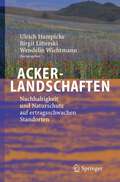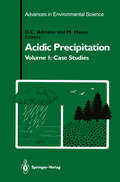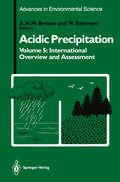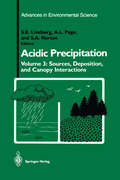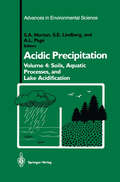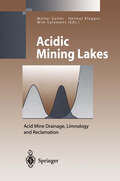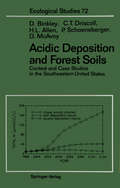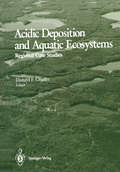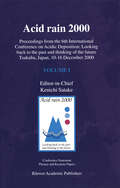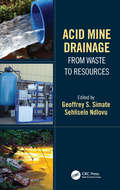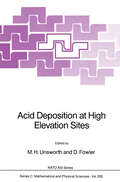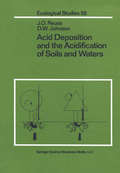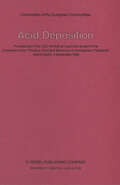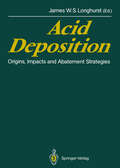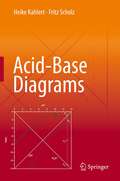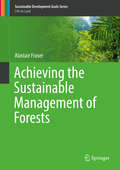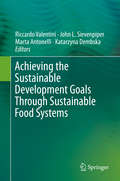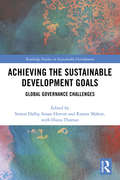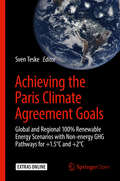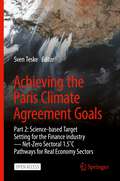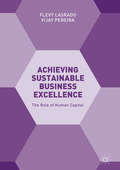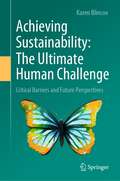- Table View
- List View
Ackerlandschaften: Nachhaltigkeit und Naturschutz auf ertragsschwachen Standorten
by Ulrich Hampicke Birgit Literski Wendelin WichtmannIn weiten Gebieten Mitteleuropas ist Ackerbau auf ertragsschwachen Standorten nur mit öffentlicher Förderung kostendeckend. Diese ist für die nähere Zukunft gesichert, langfristig aber ungewiss. Eine großflächige Aufgabe des Ackerbaus wäre aus zahlreichen Gründen problematisch. Ausgehend von einer historischen Betrachtung untersucht dieses Buch Perspektiven eines extensiven, multifunktionellen Ackerbaus, der Naturschutz und Erholungseignung in sein Zielbündel integriert. Anbautechnik, Fruchtfolgen sowie Wirkungen auf Bodenfruchtbarkeit, Wasserhaushalt und Artenvielfalt werden vorgestellt. Detailliert ermittelt werden sodann die gesellschaftlichen Kosten dieses Landnutzungssystems, die sich im Vergleich mit anderen als gering erweisen. Der Erholungswert wird mittels Zahlungsbereitschaftsanalysen erhoben. Die Gegenüberstellung von Kosten und Nutzen, die Akzeptanz von Seiten der Landwirtschaft sowie weitere wichtige Aspekte sprechen dafür, dem extensiven Ackerbau einen Platz im Spektrum künftiger Landnutzungen einzuräumen.
Acidic Precipitation: Case Studies (Advances in Environmental Science #1)
by D. C. Adriano M. Havas"awareness" of the world's citizens and encourage governments to devote more attention and resources to address this issue. The series editors thank the international panel of contributors for bringing this timely series into completion. We also wish to acknowledge the very insightful input of the following colleagues: Prof. A.L. Page of the University of California, Prof. T.C. Hutchinson of the University of Toronto, and Dr. Steve Lindberg of the Oak Ridge National Laboratory. We also wish to thank the superb effort and cooperation of the volume editors in handling their respective volumes. The constructive criticisms of chapter review ers also deserve much appreciation. Finally, we wish to convey our appreciation to my secretary, Ms. Brenda Rosier, and my technician, Ms. Claire Carlson, for their very able assistance in various aspects of this series. Aiken, South Carolina Domy C. Adriano Coordinating Editor Preface to Acidic Precipitation, Volume 1 (Advances in Environmental Science) As a result of pioneering research in the 1960s and because of the perceived and acidic real environmental effects described during the ensuing years, the terms rain, acidic deposition, or acidic precipitation have become commonplace in the scientific and popular literature. In the last decade, governments throughout the world have responded to public pressure and to the concerns of the scientific community by establishing research programs on national and international scales.
Acidic Precipitation: International Overview and Assessment (Advances in Environmental Science #5)
by A. H. M. Bresser W. Salomons Wim Salomons"awareness" of the world's citizens and encourage governments to devote more attention and resources to address this issue. The series editors thank the international panel of contributors for bringing this timely series into completion. We also wish to acknowledge the very insightful input of the following colleagues: Prof. A. L. Page of the University of California, Prof. T . C. Hutchinson of the University of Toronto , and Dr. Steve Lindberg of the Oak Ridge National Laboratory. We also wish to thank the superb effort and cooperation of the volume editors in handling their respective volumes. The constructive criticisms of chapter review ers also deserve much appreciation. Finally, we wish to convey our appreciation to my secretary, Ms. Brenda Rosier, and my technician, Ms. Claire Carlson, for their very able assistance in various aspects of this series. Aiken, South Carolina Domy C. Adriano Coordinating Editor Preface to Acidic Precipitation, Volume 5 (Advances in Environmental Science) Acidification research has been ongoing for several decades. It was not until the 1980s, however, that scientists began to recognize the complex ity of the factors causing the decline in forest growth and deterioration of fish populations in acidified lakes. The general feeling, based on correla tive research, was that long-range transported air pollution was the main cause. Proof, however, was difficult to obtain because of complex interac tions of various stress factors including natural ones.
Acidic Precipitation: Sources, Deposition, and Canopy Interactions (Advances in Environmental Science #3)
by S. E. Lindberg Al Page S. A. Nortoncountries accelerating to reach a consensus on the role that atmospheric emissions and acidic precipitation play in the environment, publication of this series is timely. The editors thank the contributors to this volume for their efforts in describing a wide array of atmospheric topics, all of which are important to an understanding of the acidic precipitation issue. Oak Ridge, Tennessee Steven E Lindberg Riverside, California Albert L. Page Orono, Maine Stephen A. Norton Contents Series Preface .................................................... v Preface... ....... ...... ..... ... .. ............................... .. vii Contributors ..................................................... xiii Sources of Acids, Bases, and Their Precursors in the Atmosphere . . . 1 Roger L. Tanner I. Introduction and Definitions. . . . . . . . . . . . . . . . . . . . . . . . . . . . . . . . . . . . . . 1 II. Sources of Acids ............................................... 3 III. Sources of Acid-Neutralizing Substances (Bases) ................... 9 IV. Distribution of Atmospheric Acids and Bases ...................... 10 V. Gas-Aerosol Equilibria and Boundary Layer Mixing ................ 14 VI. Summary of Significant Acid-Formation Pathways.............. . .. . 15 References ................................•................... 17 Aerosol Sulfur Association with Aluminum in Eastern North America: Evidence for Solubilization of Atmospheric Trace Metals before Deposition ......... . . . . . . . . . . 21 . . .
Acidic Precipitation: Soils, Aquatic Processes, and Lake Acidification (Advances in Environmental Science #4)
by Stephen A. Norton S. E. Lindberg Al Pagevarious places of the world. Thus, it is hoped that this up-to-date subseries would increase the "awareness" of the world's citizens and encourage governments to devote more attention and resources to address this issue. The series editors thank the international panel of contributors for bringing this timely series into completion. We also wish to acknowledge the very insightful input of the following colleagues: Prof. A. L. Page ofthe University of California, Prof. T. C. Hutchinson of the University of Toronto, and Dr. Steve Lindberg of the Oak Ridge National Laboratory. We also wish to thank the superb effort and cooperation of the volume editors in handling their respective volumes. The constructive criticisms of chapter reviewers also deserve much appreciation. Finally, we wish to convey our appreciation to my secretary, Ms. Brenda Rosier, and my technician, Ms. Claire Carlson, for their very able assistance in various aspects of this series. Aiken, South Carolina Domy C. Adriano Coordinating Editor Preface to Acidic Precipitation, Volume 4 (Advances in Environmental Science) Acidic precipitation and its effects have been the focus ofintense research for over two decades. Initially, research centered on the acidity status and acidification of surface waters and consequent impact on the status of sports fisheries; evidence suggested impacts on fisheries in Sweden and Norway, and in North America, in eastern Ontario, Quebec, and in the Adirondack Mountains of New York.
Acidic Mining Lakes: Acid Mine Drainage, Limnology and Reclamation (Environmental Science and Engineering)
by Wim Salomons, Helmut Klapper, Walter GellerAcidification is a universal problem at all mining sites in which oxygenated water comes in contact with sulfide minerals or other reduced sulfur compounds. An International Workshop was held in September 1995 at the Department for Inland Water Research of the UFZ-Centre for Environmental Research in Magdeburg on the limnology of lakes created by open-cast lignite mining, emphasizing the often observed geogenic acidification after oxidation of pyrite. The volume has 25 chapters including a chapter with results of group discussions about the topics mentioned above and further problems that were identified during the meeting. The monograph gives a baseline of the state of science on the worldwide problem of geogenic acidification of lakes following human mining activities.
Acidic Deposition and Forest Soils: Context and Case Studies of the Southeastern United States (Ecological Studies #72)
by Dan Binkley Charles T. Driscoll H. Lee Allen Philip Schoeneberger Drew McAvoyKnowledge in the field of acidic deposition is expanding rapidly, and both ex perts and non-experts are challenged to keep up with the latest information. We designed our assessment to include both the basic foundation needed by non experts and the detailed information needed by experts. Our assessment in cludes background information on acidic deposition (Chapter 1), an in-depth discussion of the nature of soil acidity and ecosystem H+ budgets (Chapter 2), and a summary of rates of deposition in the Southeastern U.S. (Chapter 3). A discussion of the nature of forest soils in the region (Chapter 4) is followed by an overview of previous assessments of soil sensitivity to acidification (Chapter 5). The potential impacts of acidic deposition on forest nutrition are described in the context of the degree of current nutrient limitation on forest productivity (Chap ter 6). The results of simulations with the MAGIC model provided evaluations of the likely sensitivity of a variety of soils representative of forest soils in the South (Chapter 7), as well as a test of soil sensitivity criteria. Our synthesis and recommendations for research (Chapter 8) also serve as an executive summary. A complementary volume in the Springer-Verlag Ecological Studies series should be consulted for information on European forests. This volume, Acidic Deposition and Forest Decline in the Fictelgebirge, edited by E.-D. Schultze and O.L. Lange, also provides greater detail on the physiologic responses of trees than we present in our regional assessment.
Acidic Deposition and Aquatic Ecosystems: Regional Case Studies
by Susan ChristieAcidic deposition and its effect on aquatic ecosystems have become major scientific and public policy issues in the United States since the early 1970s, and many diverse studies have been completed. This book is the first comprehensive, integrated synthesis of available information on current and potential effects of acidic precipitation on lakes and streams in geographic regions with a high number of low-alkalinity surface water from the Adirondacks and the Southern Blue Ridge to the Upper Midwest to the Rocky Mountains, the Sierra Nevada, and the Cascades. Written by leading authors, the book examines the current status of water chemistry and characterizes the processes controlling water chemistry on a regional basis by using and comparing high-quality data sets. Methods for the assessment of long-term changes in water chemistry and their effects in fish and other biota are also presented. The book amply illustrates the substantial diversity among geographical regions with respect to the nature of surface waters and the complexity of their response to acidic deposition. This volume will be of great interest to researchers in limnology, aquatic ecology, environmental chemistry, hydrology, and atmospheric sciences. It will also serve as an important reference for environmental managers and policy makers.
Acid rain 2000: Proceedings from the 6th International Conference on Acidic Deposition: Looking back to the past and thinking of the future, Tsukuba, Japan, 10–16 December 2000
by Kenichi SatakeThe Acid Rain 2000 Conference in Tsukuba, Japan, held 10-16 December 2000, was the sixth such conference in the series, starting with Columbus, Ohio, USA, in 1975, and including Sandefjord, Norway, in 1980, Muskoka, Canada, in 1985, Glasgow, UK, in 1990, and Göteborg, Sweden, in 1995. This series of International Conferences on the acid rain problem has made a very important contribution to the process of summarising the state of current understanding and making this information available. In the 6th Conference, approximately 600 papers were presented, including talks and posters. About 300 peer-reviewed papers from the presentation appear in this volume, and will provide readers with a comprehensive review of the history and scientific aspects of the acid rain problem. The papers appear in three volumes: the first containing the plenary and keynote papers and the other two the remaining scientific papers. (Volume 1: ISBN 0-7923-7132-1; Volume 2: ISBN 0-7923-7133-X; Volume 3: ISBN 0-7923-7134-8). The Conference was arranged under the joint auspices of The Science Council of Japan, The Japanese Society of Limnology (representative academic society), Japan Association of Aerosol Science and Technology, The Japan Society for Analytical Chemistry, Japan Society for Atmospheric Environment, Chemical Society of Japan, The Ecological Society of Japan, The Japanese Society of Environmental Education, Society of Environmental Science, Japan, The Japanese Forestry Society, Japanese Society of Snow and Ice, Japanese Society of Soil Science and Plant Nutrition, and Japan Society on Water Environment, with the cooperation of Ibaraki Prefecture and Japan Environment Agency.
Acid Mine Drainage: From Waste to Resources
by Geoffrey S. Simate Sehliselo NdlovuAcid mine drainage (AMD) is essentially the flow of water polluted with metals and other substances from existing/old mining areas and is considered to be one of the sources of pollution. A wide range of technologies are available for preventing AMD generation and/or treating AMD before discharge, but there is a shift towards recovery of industrially useful materials and products from AMD. Acid Mine Drainage: From Waste to Resources explores novel methods developed for the reuse and/or recovery of industrially useful materials from AMD including discussing generation, prediction, prevention, and remediation processes. It includes legislation and policy frameworks governing AMD and its environmental/health impacts. Provides a detailed overview of the mining operations and discusses the geochemical and hydrogeological context of acid mine drainage AMD formation, prediction and impact Presents a holistic approach to AMD generation, prediction, prevention, and remediation processes Presents exclusive material on reuse, recycling, and recovery of industrially useful materials from AMD Gives a detailed overview of the legislation and policy regulatory framework governing the management of AMD Analyses the effects of AMD on the environment and health This volume is aimed at researchers and professionals in metallurgical engineering, chemical engineering, environmental engineering, and mining engineering, including policy makers.
Acid Mine Drainage: From Waste to Resources
by Geoffrey S. Simate Sehliselo NdlovuAcid mine drainage (AMD) is essentially the flow of water polluted with metals and other substances from existing/old mining areas and is considered to be one of the sources of pollution. A wide range of technologies are available for preventing AMD generation and/or treating AMD before discharge, but there is a shift towards recovery of industrially useful materials and products from AMD. Acid Mine Drainage: From Waste to Resources explores novel methods developed for the reuse and/or recovery of industrially useful materials from AMD including discussing generation, prediction, prevention, and remediation processes. It includes legislation and policy frameworks governing AMD and its environmental/health impacts. Provides a detailed overview of the mining operations and discusses the geochemical and hydrogeological context of acid mine drainage AMD formation, prediction and impact Presents a holistic approach to AMD generation, prediction, prevention, and remediation processes Presents exclusive material on reuse, recycling, and recovery of industrially useful materials from AMD Gives a detailed overview of the legislation and policy regulatory framework governing the management of AMD Analyses the effects of AMD on the environment and health This volume is aimed at researchers and professionals in metallurgical engineering, chemical engineering, environmental engineering, and mining engineering, including policy makers.
Acid Deposition at High Elevation Sites (Nato Science Series C: #252)
by M. H. Unsworth D. FowlerThere is no shortage of general books on the subject of acid rain, or of symposium proceedings reviewing work ranging from atmospheric chemistry and deposition processes to freshwater acidification and effects on vegetation. In contrast, the collection of papers from this Workshop is focussed on a much smaller subject, the processes of acid deposition at high altitude sites. Interest in deposition at high elevation sites comes largely from observed vertical gradients in the degree of forest damage at sites in the Federal Republic of Germany and the eastern United States. These gradients show that damage to Norway spruce and fir increases with altitude at sites in Bavaria and the Black Forest, and that Red spruce are declining at high elevation sites in the Appalachian Mountains. With the large scale of scientific interest in forest decline, cany research groups, during the last five years, have been examining atmospheric chemistry, deposition processes, and effects on vegetation and soils at upland sites. In particular there have been many recent studies of cloud and precipitation chemistry, which show much larger concentrations of all ions in cloud water than in rain or snow. These studies have also shown that processes of wet and dry deposition and also the chemistry of the air at hill tops are modified strongly by orographic effects.
Acid Deposition and the Acidification of Soils and Waters (Ecological Studies #59)
by J.O. Reuss D.W. JohnsonThe majority of this book was written in 1983-84 while the senior author was a Visiting Scientist at Oak Ridge National Laboratory (ORNL) in Oak Ridge, Tennessee. We believe that the approach to the problem of acid deposition effects on soils and waters developed during this collaboration contains ele ments that are significantly different from most prior work in this area. Some of the material and the software used in the development of these concepts stem from earlier individual efforts of the authors. However, what we believe to be the more significant concepts concerning the processes by which alkalinity may be developed in acid soil solutions, and by which acid deposition may contrib ute to the loss of this alkalinity, were the result of this collaboration. The ultimate usefulness of these concepts in understanding and dealing with various aspects of the problems associated with acid deposition cannot be adequately gauged at the present time. They must first withstand tests of con sistency with available observation, and of direct experimentation. It is our hope that dissemination through this book will facilitate this process within the scientific community. The authors wish to thank the administration of the Environmental Science Division at ORNL, and the College of Agricultural Sciences at Colorado State University for their support in arranging this collaboration. We also wish to express our appreciation for the financial support provided by EPA. Personal thanks are due to Dr.
Acid Deposition: Proceedings of the CEC Workshop organized as part of the Concerted Action “Physico-Chemical Behaviour of Atmospheric Pollutants”, held in Berlin, 9 September 1982
by S. Beilke A. J. ElshoutProceedings of the EEC Workshop organized within the Framework of the Concerted Action "Physico-Chemical Behaviour of Atmospheric Pollutants", held in Berlin, 9 September 1982
Acid Deposition: Origins, Impacts and Abatement Strategies
by James W. S. LonghurstThe subject of acid deposition remains one of the most urgent of our contemporary environmental problems. Research programmes are continually redefming our understanding of cause and effect and hence the continuing need for a timely and authoritative series addressing these issues. This volume seeks to review and defme our contemporary understanding of acid deposition by reference to new international data and as a consequence assist the definition of our future research requirements and policy developments. International contributions to the volume are drawn from the Federal Republic of Germany, the U.S.A., Canada, Brazil, Switzerland, Austria, Israel, France and the United Kingdom. Some of these nations have experienced acid deposition on a regional scale for considerable periods of time; for others the phenomenon is an emerging problem. This collection of papers has been compiled by invitation to eminent members of the acid deposition research community and by selection from a carefully targeted call for papers. It is primarily designed to meet the needs of researchers, lecturers and postgraduate students in environmental disciplines and for environmental policy makers. It is of interest to professionals in related disciplines and essential as a reference text for libraries. The volume is divided into four broad themes: Emissions, chemistry and deposition; Ecosystem effects (freshwater, soils and forest systems); Effects on structural materials; Mitigation, control and management. Each of these sections provides an overview of contemporary understanding, presents new experimental or field evidence and provides guidance for our future research agenda.
Acid-Base Diagrams
by Heike Kahlert Fritz ScholzUnderstanding acid-base equilibria made easy for students in chemistry, biochemistry, biology, environmental and earth sciences. Solving chemical problems, be it in education or in real life, often requires the understanding of the acid-base equilibria behind them. Based on many years of teaching experience, Heike Kahlert and Fritz Scholz present a powerful tool to meet such challenges. They provide a simple guide to the fundamentals and applications of acid-base diagrams, avoiding complex mathematics. This textbook is richly illustrated and has full color throughout. It offers learning features such as boxed results and a collection of formulae.
Achieving the Sustainable Management of Forests (Sustainable Development Goals Series)
by Alastair FraserThis book discusses the reality of implementing sustainable forest management measures. Rather than simply offering theoretical descriptions, the book comprehensively details how sustainably managed forests can only be achieved through the cooperation and support of foresters, politicians, business leaders, local communities, consumers of forest-based goods and services, and the general public. The book also aims to raise public awareness of the factors involved in attaining the true sustainability of forest management, and the consequences of failing to do so, as well as the current issues facing sustainable forest management such as land ownership and land-use rights, political corruption, environmental stressors, and economic pressure. In 17 chapters, the book will appeal to academics and teachers in forestry and related areas, government practitioners, development agencies, and NGOs.
Achieving the Sustainable Development Goals Through Sustainable Food Systems (Food And Health Ser.)
by Riccardo Valentini John L. Sievenpiper Marta Antonelli Katarzyna DembskaThis publication offers a systemic analysis of sustainability in the food system, taking as its framework the Sustainable Development Goals of the 2030 Agenda of the United Nations. Targeted chapters from experts in the field cover main challenges in the food system and propose methods for achieving long term sustainability. Authors focus on how sustainability can be achieved along the whole food chain and in different contexts. Timely issues such as food security, climate change and migration and sustainable agriculture are discussed in depth. The volume is unique in its multidisciplinary and multi-stakeholder approach. Chapter authors come from a variety of backgrounds, and authors include academic professors, members of CSO and other international organizations, and policy makers. This plurality allows for a nuanced analysis of sustainability goals and practices from a variety of perspectives, making the book useful to a wide range of readers working in different areas related to sustainability and food production. The book is targeted towards the academic community and practitioners in the policy, international cooperation, nutrition, geography, and social sciences fields. Professors teaching in nutrition, food technology, food sociology, geography, global economics, food systems, agriculture and agronomy, and political science and international cooperation may find this to be a useful supplemental text in their courses.
Achieving the Sustainable Development Goals: Global Governance Challenges (Routledge Studies in Sustainable Development)
by Simon Dalby Susan Horton Rianne Mahon Diana ThomazThis book draws on the expertise of faculty and colleagues at the Balsillie School of International Affairs to both locate the Sustainable Development Goals (SDGs) as a contribution to the development of global government and to examine the political-institutional and financial challenges posed by the SDGs. The contributors are experts in global governance issues in a broad variety of fields ranging from health, food systems, social policy, migration and climate change. An introductory chapter sets out the broad context of the governance challenges involved, and how individual chapters contribute to the analysis. The book begins by focusing on individual SDGs, examining briefly the background to the particular goal and evaluating the opportunities and challenges (particularly governance challenges) in achieving the goal, as well as discussing how this goal relates to other SDGs. The book goes on to address the broader issues of achieving the set of goals overall, examining the novel financing mechanisms required for an enterprise of this nature, the trade-offs involved (particularly between the urgent climate agenda and the social/economic goals), the institutional arrangements designed to enable the achievement of the goals and offering a critical perspective on the enterprise as a whole. Achieving the Sustainable Development Goals makes a distinctive contribution by covering a broad range of individual goals with contributions from experts on governance in the global climate, social and economic areas as well as providing assessments of the overall project – its financial feasibility, institutional requisites, and its failures to tackle certain problems at the core. This book will be of great interest to scholars and students of international affairs, development studies and sustainable development, as well as those engaged in policymaking nationally, internationally and those working in NGOs.
Achieving the Sustainable Development Goals: Global Governance Challenges (Routledge Studies in Sustainable Development)
by Simon Dalby Susan Horton Rianne Mahon Diana ThomazThis book draws on the expertise of faculty and colleagues at the Balsillie School of International Affairs to both locate the Sustainable Development Goals (SDGs) as a contribution to the development of global government and to examine the political-institutional and financial challenges posed by the SDGs. The contributors are experts in global governance issues in a broad variety of fields ranging from health, food systems, social policy, migration and climate change. An introductory chapter sets out the broad context of the governance challenges involved, and how individual chapters contribute to the analysis. The book begins by focusing on individual SDGs, examining briefly the background to the particular goal and evaluating the opportunities and challenges (particularly governance challenges) in achieving the goal, as well as discussing how this goal relates to other SDGs. The book goes on to address the broader issues of achieving the set of goals overall, examining the novel financing mechanisms required for an enterprise of this nature, the trade-offs involved (particularly between the urgent climate agenda and the social/economic goals), the institutional arrangements designed to enable the achievement of the goals and offering a critical perspective on the enterprise as a whole. Achieving the Sustainable Development Goals makes a distinctive contribution by covering a broad range of individual goals with contributions from experts on governance in the global climate, social and economic areas as well as providing assessments of the overall project – its financial feasibility, institutional requisites, and its failures to tackle certain problems at the core. This book will be of great interest to scholars and students of international affairs, development studies and sustainable development, as well as those engaged in policymaking nationally, internationally and those working in NGOs.
Achieving the Paris Climate Agreement Goals: Global and Regional 100% Renewable Energy Scenarios with Non-energy GHG Pathways for +1.5°C and +2°C
by Sven TeskeThis open access book presents detailed pathways to achieve 100% renewable energy by 2050, globally and across ten geographical regions. Based on state-of-the-art scenario modelling, it provides the vital missing link between renewable energy targets and the measures needed to achieve them. Bringing together the latest research in climate science, renewable energy technology, employment and resource impacts, the book breaks new ground by covering all the elements essential to achieving the ambitious climate mitigation targets set out in the Paris Climate Agreement. For example, sectoral implementation pathways, with special emphasis on differences between developed and developing countries and regional conditions, provide tools to implement the scenarios globally and domestically. Non-energy greenhouse gas mitigation scenarios define a sustainable pathway for land-use change and the agricultural sector. Furthermore, results of the impact of the scenarios on employment and mineral and resource requirements provide vital insight on economic and resource management implications. The book clearly demonstrates that the goals of the Paris Agreement are achievable and feasible with current technology and are beneficial in economic and employment terms. It is essential reading for anyone with responsibility for implementing renewable energy or climate targets internationally or domestically, including climate policy negotiators, policy-makers at all levels of government, businesses with renewable energy commitments, researchers and the renewable energy industry.
Achieving the Paris Climate Agreement Goals: Part 2: Science-based Target Setting for the Finance industry — Net-Zero Sectoral 1.5˚C Pathways for Real Economy Sectors
by Sven TeskeThis open access book is designed as a continuation of the editor’s 2019 book Achieving the Paris Climate Agreement Goals. This volume provides an in-depth analysis of industry sectors globally, and its purpose is to present emission reduction targets in 5-year steps (2025 to 2050) for the main twelve finance sectors per the Global Industry Classification System. This scientific analysis aims to support the United Nations Principles for Responsible Investment initiative to give sustainability guidance for the global finance industry. The industry sector pathways presented here are based on the latest global and regional 100% renewable energy and non-energy greenhouse gas Representative Concentration Pathways in order to keep climate change significantly under +1.5 C and thereby achieve the Paris Climate Agreement goals. The heart of this book is three chapters presenting the results of industry scenario modelling. These chapters cover twelve industry and service sectors as well as transportation and buildings. The specific energy demand and specific emissions are presented based on the emission accounting concept of “Scope 1, Scope 2 and Scope 3” emission pathways. This methodology has been developed to measure the climate and sustainability index for companies, and this research project expands the methodology to apply it to entire industry sectors. The results presented here are the first overall industry assessments under Scope 1, 2 and 3 from 2020 through 2050. The base for the energy pathways is the scenarios scenarios published in the previous volume. The nonenergy GHG emission scenarios, broken down to agriculture & forestry and industry, are detailed and include all major greenhouse gases and aerosols. The final section of the book presents the main conclusions of the industry pathway development work and recommendations for the finance industry and policy makers. Additionally, future qualitative future investment requirements in specific technologies and measures are presented.
Achieving Sustainable Business Excellence: The Role of Human Capital
by Vijay Pereira Flevy LasradoCompiling the best practices of business excellence frameworks around the world, this new book addresses the need for innovative research on sustainable business performance. Using detailed empirical studies, the authors outline the motives and benefits of the implementation of such frameworks in different geographical regions. Comprehensive case studies showcase how the variety of excellence frameworks are manifested in their work cultures, values and beliefs. Academics studying quality management, HRM, and international business will find this book an essential read as it establishes the relevance of human capital in achieving and sustaining global business excellence.
Achieving Sustainable Business Excellence: The Role of Human Capital
by Vijay Pereira Flevy LasradoCompiling the best practices of business excellence frameworks around the world, this new book addresses the need for innovative research on sustainable business performance. Using detailed empirical studies, the authors outline the motives and benefits of the implementation of such frameworks in different geographical regions. Comprehensive case studies showcase how the variety of excellence frameworks are manifested in their work cultures, values and beliefs. Academics studying quality management, HRM, and international business will find this book an essential read as it establishes the relevance of human capital in achieving and sustaining global business excellence.
Achieving Sustainability: Critical Barriers and Future Perspectives
by Karen BlincoeThe book provides an assessment of whether sustainability is realizable in the current societal framework. What are the challenges and the barriers - and what are the levers necessary to meet and overcome them?Through a revision of the essence of sustainability the book provides an opportunity to understand the deeper level of the radical change that sustainability represents, and the resistance that is preventing its realization.To build the argument the sustainable development model is compared with current development theories as well as alternative solutions based on utopian models of the past. The book assesses the results that can be achieved within the current systemic framework, based on case stories. It outlines the limitations to sustainability, pointing out and defining the multiple, cross-sectoral and systemic barriers that hinder the transition.Finally, the book offers perspectives on achieving a sustainable future, encompassing the impacts from recent events including the pandemic as well as the multiple mitigation and transition initiatives undertaken globally.Brian Goodwin's QuoteLike the caterpillar that wraps itself up in its silken swaddling bands prior to its metamorphosis into a butterfly, we have wrapped ourselves in a tangled skin from which we can emerge only by going through a similarly dramatic transformation.
